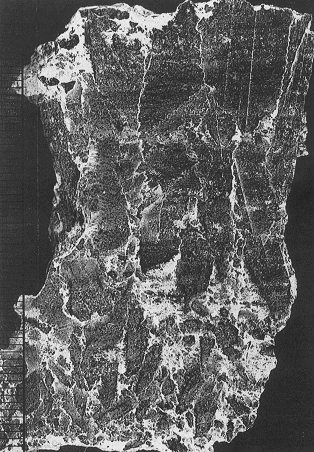
Bacterial mat embedded in gypsum crystals
Plate 142

Bacterial mat embedded in gypsum crystals
Plate 142
This polished section shows an aggregate of large gypsum crystals (the variety called selenite). A graduated scale in millimeters is shown on the left side of the picture. In the upper part, the crystals are in place and form a sort of palisade, which rests on a substrate of detrital gypsum. They have a swallow-tail, or spear-head shape, deriving from their upward growing and twinned character. This orientation provides a way-up criterion, particularly useful in poorly bedded sequences (crystals converge downwards, according to the so-called Mottura rule applied in old sulfur mines of Sicily). Other examples of selenitic gypsum can be seen in plate 167 and color photo 30.
The horizontal lamination that is visible in the upper crystals is biogenic (which means "of biological origin"; therefore, one should not say "of biogenic origin"). They consist of superposed felts of tiny bacterial filaments (enlarged in plate 143). Bacterial mats and selenite crystals grew more or less simultaneously on a muddy bottom at the margin of a shallow-water body. The two processes were competitive, with both mat and crystals growing upward. The selenite incorporated the mat, which could survive only if the crystals did not outpace it. From time to time, violent storms broke the crystals and mats, accumulating layers of gypsum breccia and gypsum sand; bacterial mats formed again on them, as well as selenite crystals.
Messinian Vena del Gesso, northern Apennines.
| Photo: P. Ferrieri 1976. |